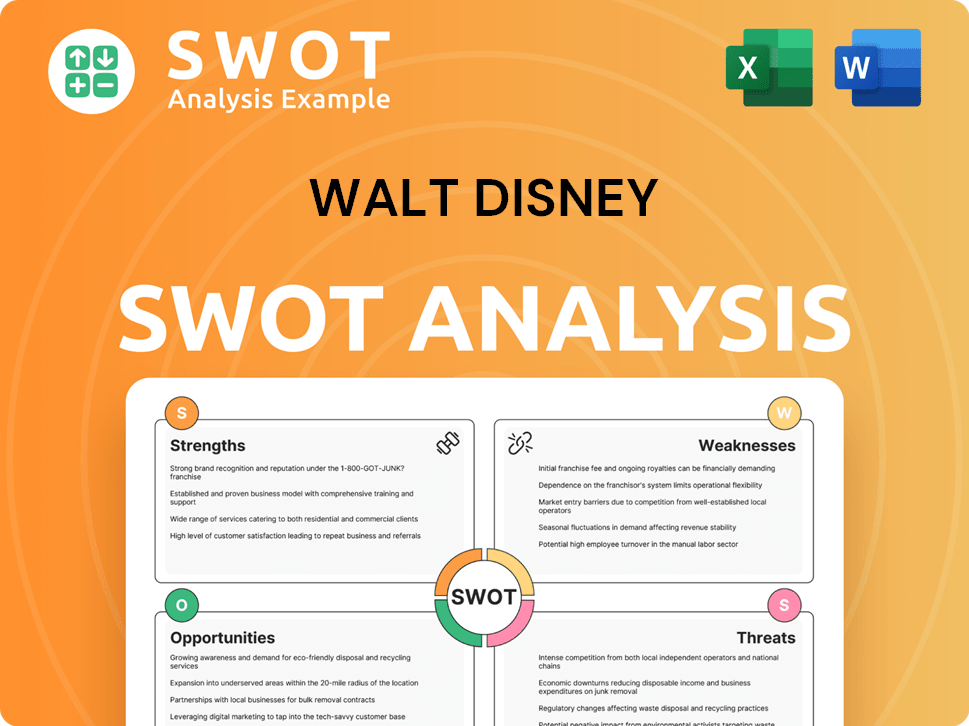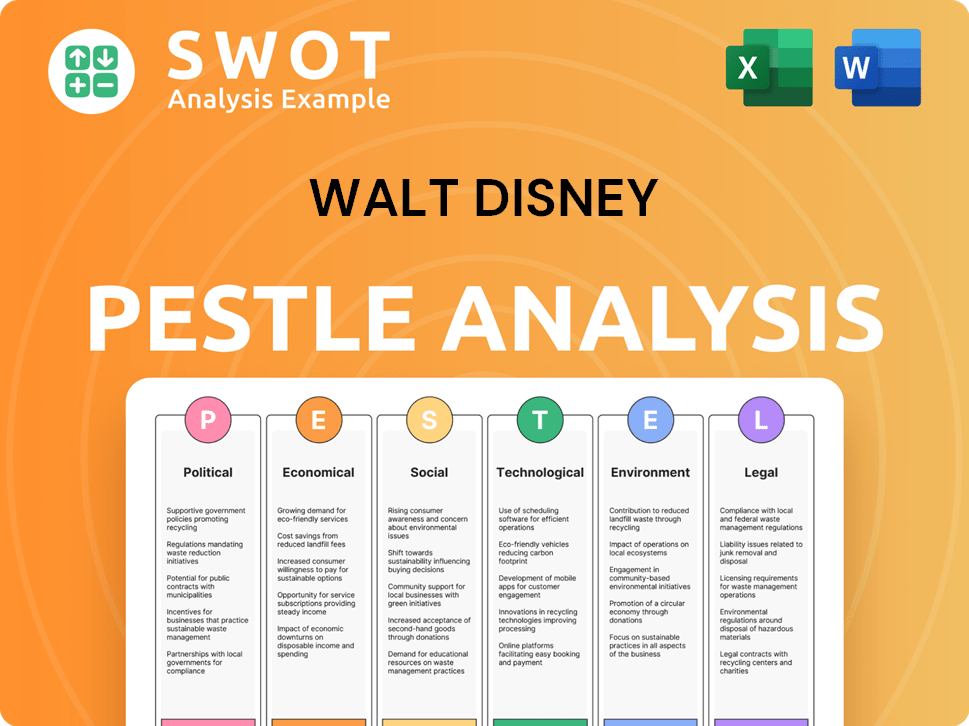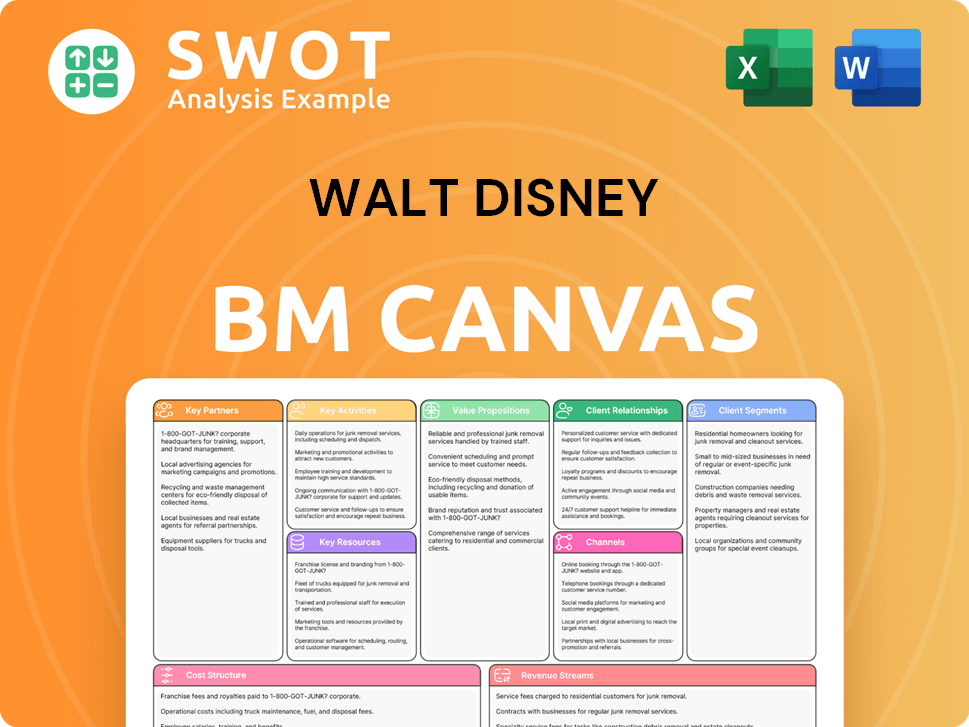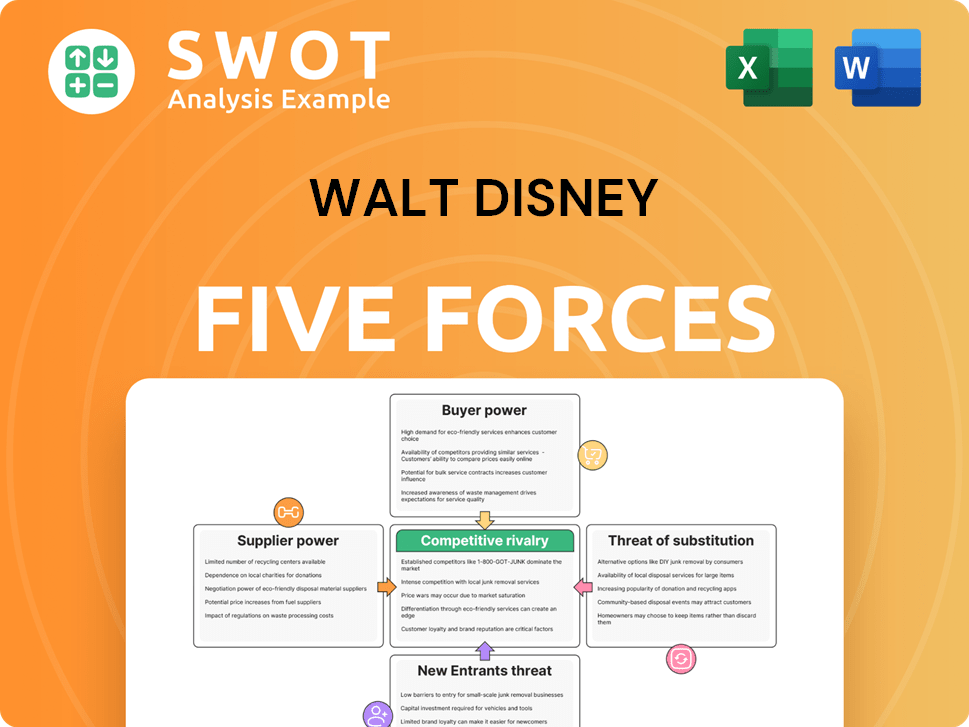Walt Disney Bundle
Can Disney Maintain Its Magic in a Changing World?
The acquisition of 21st Century Fox in 2019 was a game-changer for The Walt Disney Company, fundamentally altering the media landscape and highlighting the critical need for a robust growth strategy. From its humble beginnings in 1923, Disney has transformed into a global entertainment giant, now valued at over $200 billion. This article dives into Disney's ambitious plans for future expansion, innovation, and strategic planning to maintain its leading position in the dynamic global market.

This exploration will delve into the core of Disney's Walt Disney SWOT Analysis, examining its Walt Disney Company Growth Strategy and the exciting Disney Future Prospects. We'll uncover how Disney leverages its diverse Disney Revenue Streams and ambitious Disney Expansion Plans to navigate the complex Entertainment Industry Trends. Understanding Disney's Disney Business Model is crucial to comprehending its long-term success and its ability to compete with industry giants like Netflix, while also analyzing its Disney's theme park expansion strategies and Disney's international market growth.
How Is Walt Disney Expanding Its Reach?
The Target Market of Walt Disney is actively pursuing a multi-faceted growth strategy to broaden its market reach and diversify its revenue streams. This strategy focuses on expanding its direct-to-consumer (DTC) streaming services, theme park presence, and cruise line fleet. These initiatives are designed to access new customer segments, bolster recurring revenue, and maintain a competitive edge in the dynamic entertainment and leisure industries. The company's expansion plans are a key part of its long-term business strategy, aiming to solidify its position in the entertainment industry.
A significant portion of Disney's strategy involves its streaming services, including Disney+, Hulu, and ESPN+. The integration of Hulu content into Disney+ by the end of 2024 is a strategic move to create a more unified streaming experience. This integration is expected to enhance content offerings and reduce churn, providing a more comprehensive entertainment library for subscribers. This is a key element in Disney's efforts to compete with other major streaming platforms and drive subscriber growth. The company is also focused on the geographical expansion of its theme park presence, particularly in Asia.
Disney is also exploring new business models, such as expanding its cruise line fleet. New ships like the Disney Treasure, expected to debut in late 2024, and the Disney Adventure, set for 2025, are designed to tap into the growing experiential tourism market. These expansions are designed to access new customer segments and bolster recurring revenue, ensuring the company's competitive edge in the entertainment and leisure industries. These moves are part of a broader strategy to diversify revenue streams and maintain long-term growth.
Disney plans to fully integrate Hulu content into Disney+ by the end of 2024. This consolidation aims to create a more unified streaming experience, potentially driving subscriber growth and reducing churn. The move is crucial for competing in the crowded streaming market.
Continuous investment in existing parks like Walt Disney World and Disneyland is ongoing, including new attractions and technological upgrades. Disney is also focused on expanding its theme park presence, particularly in Asia. These expansions are designed to attract more visitors.
The company is expanding its cruise line fleet with new ships. The Disney Treasure is expected to debut in late 2024, and the Disney Adventure is slated for 2025. This expansion taps into the growing experiential tourism market.
Disney is exploring new business models to diversify its revenue streams. Expanding its cruise line fleet with new ships is a key strategy. This helps to reach new customer segments and maintain a competitive edge.
Disney's growth strategy focuses on expanding its DTC streaming services, theme parks, and cruise line fleet. These initiatives are designed to drive revenue and maintain a competitive edge in the entertainment industry. The company is adapting to digital media and focusing on international market growth.
- Integration of Hulu into Disney+ to create a unified streaming experience.
- Continuous investment in existing theme parks and expansion in Asia.
- Expansion of the cruise line fleet with new ships like the Disney Treasure and Disney Adventure.
- Focus on new business models to diversify revenue streams.
Walt Disney SWOT Analysis
- Complete SWOT Breakdown
- Fully Customizable
- Editable in Excel & Word
- Professional Formatting
- Investor-Ready Format

How Does Walt Disney Invest in Innovation?
The company strategically uses innovation and technology to drive its growth, focusing on enhancing consumer experiences and optimizing content delivery. This approach is central to its long-term success, influencing both its financial performance and its position in the entertainment industry. The company's commitment to technological advancements is evident in its investments in research and development.
The company's digital transformation efforts are critical, particularly in streaming technology. This ensures seamless, high-quality content delivery globally. This focus on technology not only attracts new audiences but also reinforces its leadership in creating cutting-edge entertainment experiences.
The company's strategic initiatives include integrating environmentally friendly practices into its operations, from theme parks to content production. This demonstrates a commitment to sustainability that resonates with consumers and supports its long-term business strategy.
The company is exploring the use of artificial intelligence (AI) for personalized content recommendations on streaming platforms like Disney+. This enhances the user experience and increases engagement.
Advanced animatronics and digital integration are being used in theme park attractions, such as the upcoming 'Zootopia' land at Shanghai Disneyland. This enhances the immersive experience for visitors.
The company is continuously improving its proprietary streaming technology to ensure seamless delivery of high-quality video content. This is crucial for its growth in streaming services.
Sustainability is a key focus, with environmentally friendly practices integrated into theme parks and content production. This supports the company's long-term goals and appeals to environmentally conscious consumers.
The company is actively adapting to digital media, including advancements in its proprietary streaming technology. This is a key part of its strategy to compete with Netflix and other streaming services.
Significant investment in research and development, particularly in AI and VR, enhances storytelling and theme park attractions. This is a core part of its strategic initiatives.
The company's focus on innovation and technology is a core part of its Walt Disney Company Growth Strategy. This approach not only helps attract new audiences but also reinforces its leadership in the entertainment industry. For more insights, consider reading about Mission, Vision & Core Values of Walt Disney.
The company's investments in technology and innovation are designed to enhance consumer experiences and optimize content delivery, contributing to its Disney Future Prospects.
- AI-driven personalized content recommendations on Disney+.
- Advanced animatronics and digital integration in theme park attractions.
- Continuous improvements in proprietary streaming technology.
- Integration of environmentally friendly practices in operations.
- Focus on immersive technologies to create cutting-edge entertainment.
Walt Disney PESTLE Analysis
- Covers All 6 PESTLE Categories
- No Research Needed – Save Hours of Work
- Built by Experts, Trusted by Consultants
- Instant Download, Ready to Use
- 100% Editable, Fully Customizable

What Is Walt Disney’s Growth Forecast?
The financial outlook for The Walt Disney Company is positive, driven by strategic initiatives and disciplined financial management. The company's growth strategy focuses on enhancing profitability, reducing debt, and generating robust free cash flow. This approach supports future investments and shareholder returns, underpinned by a strong brand and diversified revenue streams. The company is actively navigating entertainment industry trends to maintain its competitive edge.
For the first fiscal quarter of 2024, Disney reported diluted earnings per share (EPS) from continuing operations of $0.82, a significant increase from $0.70 in the prior-year quarter. Revenues for the quarter reached $23.5 billion. These results reflect the company's ability to adapt and thrive in a dynamic market.
Disney's commitment to operational efficiency and strategic investments positions it well for sustained growth. The company's financial ambitions are supported by its diverse business segments, including parks, experiences, and products; entertainment; and sports. The company is also focused on Disney's growth in streaming services, aiming to achieve significant profitability in its combined streaming businesses by the fourth quarter of fiscal 2024.
Disney is targeting fiscal year 2024 adjusted EPS growth of at least 20% compared to fiscal 2023. This ambitious goal demonstrates the company's confidence in its strategic initiatives and operational improvements. These targets reflect a commitment to delivering value to shareholders and maintaining a strong financial position.
The company is aiming for significant profitability in its combined streaming businesses by the fourth quarter of fiscal 2024. This strategic move is supported by efforts to optimize content spending and increase subscriber engagement across Disney+, Hulu, and ESPN+. The company's focus on streaming is a key part of how Disney plans to compete with Netflix.
Disney is aiming for approximately $3 billion in annualized savings by the end of fiscal 2024. These savings will be achieved through various operational efficiencies and cost-cutting measures. This focus on cost management will contribute to improved profitability and financial flexibility. The company's strategic initiatives also include plans for new theme park attractions.
Disney's diversified revenue streams, including parks, experiences, products, entertainment, and sports, provide a solid foundation for growth. The company's ability to generate revenue from multiple sources reduces its reliance on any single segment. This diversified approach supports Disney's expansion plans and helps the company navigate challenges effectively.
The company's strategic initiatives and disciplined financial management are key drivers of its positive financial outlook. For a deeper dive into how the company approaches its marketing, consider reading about the Marketing Strategy of Walt Disney.
Walt Disney Business Model Canvas
- Complete 9-Block Business Model Canvas
- Effortlessly Communicate Your Business Strategy
- Investor-Ready BMC Format
- 100% Editable and Customizable
- Clear and Structured Layout

What Risks Could Slow Walt Disney’s Growth?
The Walt Disney Company's ambitious growth strategy faces several potential risks and obstacles that could impact its future. These challenges span from intense competition in the entertainment industry to internal management complexities. Navigating these hurdles will be crucial for sustaining the company's growth trajectory and achieving its long-term goals.
Market dynamics, technological advancements, and economic conditions all play a significant role in shaping the landscape for the entertainment giant. Understanding and proactively addressing these risks is essential for maintaining its competitive edge and ensuring continued success. This requires a multifaceted approach that includes strategic diversification, robust risk management, and adaptive planning.
The competitive landscape in the streaming market is fierce, with numerous players vying for subscriber attention. This poses a significant challenge for Disney's streaming services. Regulatory changes, particularly concerning content ownership and intellectual property rights, could also create hurdles. Supply chain vulnerabilities, especially impacting merchandise and theme park operations, can lead to increased costs or disruptions. The rapid pace of technological disruption, including evolving consumer preferences and the emergence of new platforms, necessitates continuous adaptation and investment to remain relevant.
The intense competition in the streaming market, with rivals like Netflix and others, creates a need for continuous innovation and investment in content. To compete effectively, Disney must consistently offer compelling content and competitive pricing. The success of Disney's streaming services, including Disney+, Hulu, and ESPN+, is critical to its overall revenue and future growth. In Q1 2024, Disney+ saw a slight increase in subscribers, but the streaming segment still faces profitability challenges.
Changes in regulations related to content ownership, intellectual property, and international market access can significantly impact Disney's operations. Compliance with varying legal frameworks across different countries adds complexity and potential costs. The company must proactively manage these risks through legal strategies and lobbying efforts. Regulatory scrutiny over acquisitions and mergers also poses a challenge to Disney's expansion plans.
Supply chain disruptions can affect merchandise production and theme park operations, potentially leading to increased costs and reduced profitability. Geopolitical events, natural disasters, and economic fluctuations can exacerbate these vulnerabilities. Disney must diversify its supply chains and implement robust risk management strategies to mitigate these impacts. The company's theme parks and resorts are particularly susceptible to supply chain disruptions affecting construction projects and guest experiences.
Rapid technological advancements and evolving consumer preferences require continuous adaptation and investment. New platforms and content formats demand that Disney remain at the forefront of innovation. The company's ability to embrace new technologies, such as virtual reality and augmented reality, will be crucial for maintaining relevance and attracting audiences. According to recent reports, Disney is investing heavily in AI and immersive experiences to enhance its offerings.
Economic downturns can reduce consumer discretionary spending, impacting Disney's revenue streams from theme parks, movies, and consumer products. Recessions or economic slowdowns can lead to decreased attendance at theme parks and lower demand for merchandise. Disney must prepare for economic fluctuations through cost-saving measures and strategic pricing adjustments. During the 2008 recession, the company experienced a decline in theme park attendance and lower consumer spending.
Geopolitical instability can affect Disney's international operations, particularly in regions with political unrest or trade restrictions. Political tensions can disrupt market access and impact the company's ability to distribute content. Disney must monitor geopolitical developments and adjust its strategies accordingly. The company's expansion into new markets requires careful consideration of political and economic risks.
Internally, managing a vast and diverse portfolio of businesses requires significant resource allocation and strategic alignment. The company addresses these risks through diversification of its content and revenue streams, robust risk management frameworks, and proactive scenario planning. For instance, Disney has navigated challenges related to the COVID-19 pandemic's impact on theme parks and film production by accelerating its streaming strategy and implementing cost-saving measures. The company's long-term business strategy emphasizes adaptability and innovation to overcome these challenges. For more insights, read the article on the Walt Disney Company's business model and growth strategy.
Walt Disney Porter's Five Forces Analysis
- Covers All 5 Competitive Forces in Detail
- Structured for Consultants, Students, and Founders
- 100% Editable in Microsoft Word & Excel
- Instant Digital Download – Use Immediately
- Compatible with Mac & PC – Fully Unlocked

Related Blogs
- What are Mission Vision & Core Values of Walt Disney Company?
- What is Competitive Landscape of Walt Disney Company?
- How Does Walt Disney Company Work?
- What is Sales and Marketing Strategy of Walt Disney Company?
- What is Brief History of Walt Disney Company?
- Who Owns Walt Disney Company?
- What is Customer Demographics and Target Market of Walt Disney Company?
Disclaimer
All information, articles, and product details provided on this website are for general informational and educational purposes only. We do not claim any ownership over, nor do we intend to infringe upon, any trademarks, copyrights, logos, brand names, or other intellectual property mentioned or depicted on this site. Such intellectual property remains the property of its respective owners, and any references here are made solely for identification or informational purposes, without implying any affiliation, endorsement, or partnership.
We make no representations or warranties, express or implied, regarding the accuracy, completeness, or suitability of any content or products presented. Nothing on this website should be construed as legal, tax, investment, financial, medical, or other professional advice. In addition, no part of this site—including articles or product references—constitutes a solicitation, recommendation, endorsement, advertisement, or offer to buy or sell any securities, franchises, or other financial instruments, particularly in jurisdictions where such activity would be unlawful.
All content is of a general nature and may not address the specific circumstances of any individual or entity. It is not a substitute for professional advice or services. Any actions you take based on the information provided here are strictly at your own risk. You accept full responsibility for any decisions or outcomes arising from your use of this website and agree to release us from any liability in connection with your use of, or reliance upon, the content or products found herein.